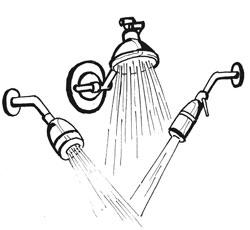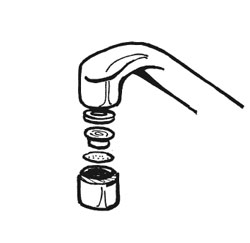Upgrading Your Existing Water Heater
Even if you aren’t going to buy a new water heater, you can save a lot of energy and money with your existing system by following a few simple suggestions.
Conserve Water
Your biggest opportunity for savings is to use less hot water. In addition to saving energy (and money), cutting your hot water use helps conserve precious water resources, a critical step in many parts of the country where supplies are scarce or water infrastructure is strained. Federal efficiency standards effective in 1994 set maximum water use requirements for showerheads and faucets at 2.5 gpm. Studies show that 1 in 4 households still use showerheads that exceed this flow rate. If you have older showerheads and faucets, consider replacing them now. Many high-quality, water-saving showerheads are available that provide impressive performance. Some models use just 1.6 gpm while offering multiple spray settings and even large water droplets. Of course, if your shower has multiple showerheads, you’ll end up using a lot more water, even if each showerhead meets or exceeds the minimum standards.
If you aren’t sure how much water your shower currently uses, you can find out with a bucket that holds at least a gallon and a watch with a second hand. Turn on the shower to the usual pressure you use, hold the bucket under it and time how many seconds it takes to fill to the one-gallon mark. If it takes less than 20 seconds, your flow rate is over 3 gpm, and your shower is a good candidate for a water-saving showerhead. Many older showerheads deliver 4–5 gpm.
While faucets are also subject to the 2.5 gpm standard, there are opportunities to save even more water. Look for faucet aerators that deliver 1⁄2–1 gpm, especially if you tend to run the water when rinsing dishes. Some models are sold with a convenient shut-off valve at the aerator that allows you to temporarily turn off the water without changing the hot/cold mix. Sink aerators cost just a few dollars apiece.
Repair leaky faucets right away. Even a relatively small hot water drip can dump a lot of energy and money down the drain. Also, refer to water-saving tips with dishwashers and clothes washers.
Improve the Distribution System
Hot water distribution losses can be dramatic. Studies show that, in a typical small house, 9% of the water heating energy is lost in the distribution system. In a large house, distribution losses can be greater.
Insulating your hot water pipes will reduce losses as the hot water is flowing to your faucet, and more importantly, it will reduce standby losses when the tap is turned off and then back on within an hour or so.
A great deal of energy and water is also wasted waiting for hot water to reach the shower or tap. It is not uncommon for a home to waste thousands of gallons of water per year waiting for hot water to reach the tap. Homes with uninsulated pipes running beneath the foundation or with long distances between the water heater and bathrooms can experience a tremendous amount of heat loss. One common remedy is to install a hot water recirculation loop to continuously pump hot water through the pipes ensuring that hot water is available almost instantly, even at fixtures furthest from the water heater. Continuous recirculation systems use a lot of energy to pump water through the system and lose a lot of energy radiated from hot water traveling through the pipes. If a recirculation system is used, it is critical that the pipes are well insulated and that a timer is installed to turn the system off at night and at times when hot water use is minimal.
One superior alternative to a continuous recirculation system is a demand recirculation system. Controlled by a simple button, or even an occupancy sensor, this system delivers hot water only when needed by activating a small pump that quickly cycles the cool water standing in the hot water pipes back to the water heater, bringing hot water to the tap (these systems are discussed in greater detail under “State-of-the- Art Water Heating”). Another option if you find you often leave the shower unattended while you wait for the hot water is a device that cuts the shower flow to a trickle once hot water reaches the showerhead. This low-tech solution costs much less than recirculation, but it won’t help if you find you often wait for hot water at the kitchen or bathroom sink.
Improve Water Heater Efficiency
Insulate an older existing water heater. Installing an insulating jacket on your existing water heater is widely-touted as one of the most effective do-it-yourself energy-saving projects. Newer water heaters come with fairly high insulation levels, practically eliminating the economic advantages of adding additional insulation. In fact, some manufacturers recommend against installing insulating jackets on their energy-efficient models. If you have an older water heater, consider upgrading to a new energy-efficient model for a great return on your investment. If replacement is out of the question for another year or two, an insulating jacket may make sense for the short term. Always follow directions carefully when installing an insulation jacket. Leave the thermostat(s) accessible. With conventional gas- and oil-fired water heaters, you need to be careful not to restrict the air inlet(s) at the bottom or the draft hood at the top.
Lower the water heater temperature. Keep your water heater thermostat set at the lowest temperature that provides you with sufficient hot water. For most households, 120°F water is fine (about midway between the “low” and “medium” setting). Each 10°F reduction in water temperature will generally save 3–5% on your water heating costs. If you have a dishwasher without a booster heater, you should probably keep the water temperature up to 140°F (the “medium” setting) or buy a new, more efficient dishwasher.
Not only will lowering the thermostat save a lot of energy, but it will also increase the life of your water heater and reduce the risk of children scalding themselves with the hot water.
When you are going away on vacation, you can turn the thermostat down to the lowest possible setting, or turn the water heater off altogether for additional savings. With a gas water heater, make sure you know how to relight the pilot if you’re going to turn it off while away.



